Soundproof carpet padding is arguably one of the least intrusive ways to reduce noise transmission in a space. Installing it is theoretically pretty easy, and it’s more cost-effective than other noise reduction efforts.
In this article, I look at the best carpet padding for soundproofing. Carpet padding is just one option for flooring. If you’d like to know more, check out my article on the best soundproof underlay.
How Does Soundproof Carpet Padding Work?
Carpet padding is installed under carpeted floors to provide extra noise reduction. It’s a type of carpet underlayment, which can serve several purposes. Along with noise reduction, this can also include thermal insulation or moisture control.
It’s worth noting that most (if not all) of the information below also relates to pads for area rugs. These are basically the same thing but go below a rug rather than a whole carpet. You can achieve some soundproofing, but the materials are often thinner than a carpet underlay.
Soundproof carpet padding generally addresses impact noises, but it can also provide some help for airborne sounds. These names are fairly self-explanatory, but they’re defined as follows:
Airborne sounds travel from the source through the air to your ears. For example, TV sounds, music, or people talking are all air noise.
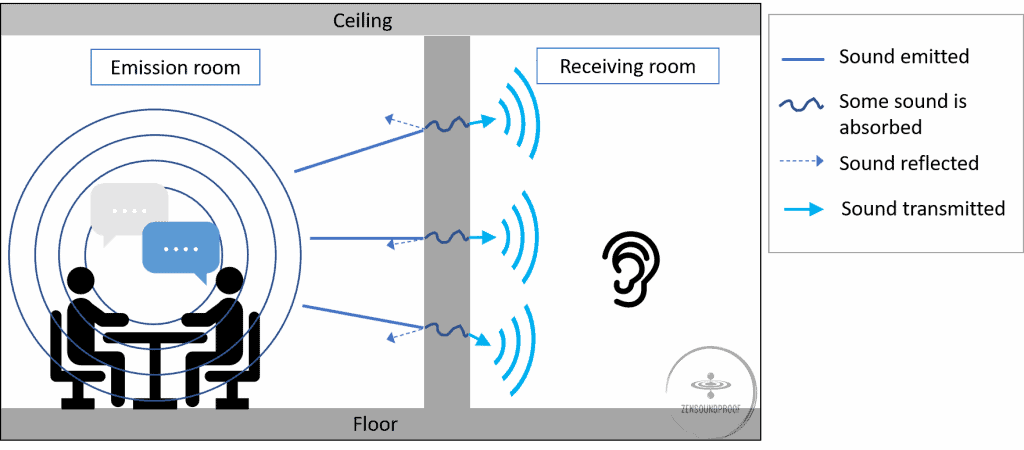
Impact sounds are when sound waves travel through a structure due to impact from a source. For example, footstep noise or a bouncing basketball would be impact sounds.

Soundproof Principles at Play
The different types of sound require different soundproofing principles for reduction. Generally, airborne sounds involve absorbing the sound to reduce transmission, whereas impact sounds involve making it more difficult for the vibrations to pass through a structure.
There are 4 main soundproofing principles. With carpet padding, we’ll only really deal with 2, although there is a small amount of sound blocking and dampening sound involved too.
Absorption
Absorption is fairly easy to understand. It involves soft and/or open-cell materials, which trap sound waves and force them to expend their energy. This happens because a sound wave enters the material and gets “trapped”, and the vibrational energy converts to heat.
Absorptive materials control echo and reverberation, specifically related to airborne sounds.
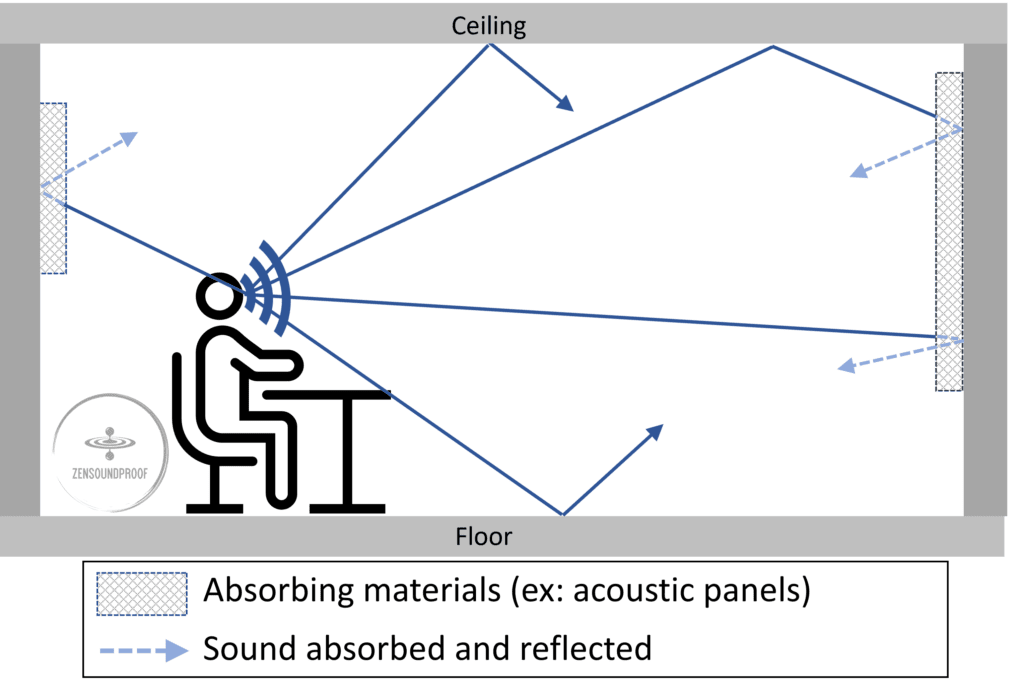
Decoupling
Also known as manual isolation, decoupling involves separating a structure from a surface (or 2 sides of a structure) to put a physical barrier in the way of the sound waves. This theoretically prevents them from passing into the structure from the noise source.
To decouple a floor from the room, we use resilient materials. These are typically lightweight materials that, importantly, have viscoelastic properties. Viscoelastic materials can vibrate but return to their original state without passing on the vibrations. In a way, it’s kind of like absorption.
Decoupling controls vibration transmission by separating 2 surfaces. It relates to impact sounds.
Metrics for Measuring Soundproofing
To measure the quality of a material’s soundproofing ability, we use 2 metrics: STC and IIC.
STC
Sound Transmission Class is a measurement that assesses how much a material reduces airborne sounds. To receive an STC rating, a material must be tested in a lab under controlled conditions.
The test measures sound intensity (in decibels) between 2 rooms with the testing material applied to a wall or floor. A higher loss in intensity means a higher STC rating, which is given as a 2-digit number. A value of 50 is the standard, which limits the transmission of noises equivalent to people talking (around 50dB).
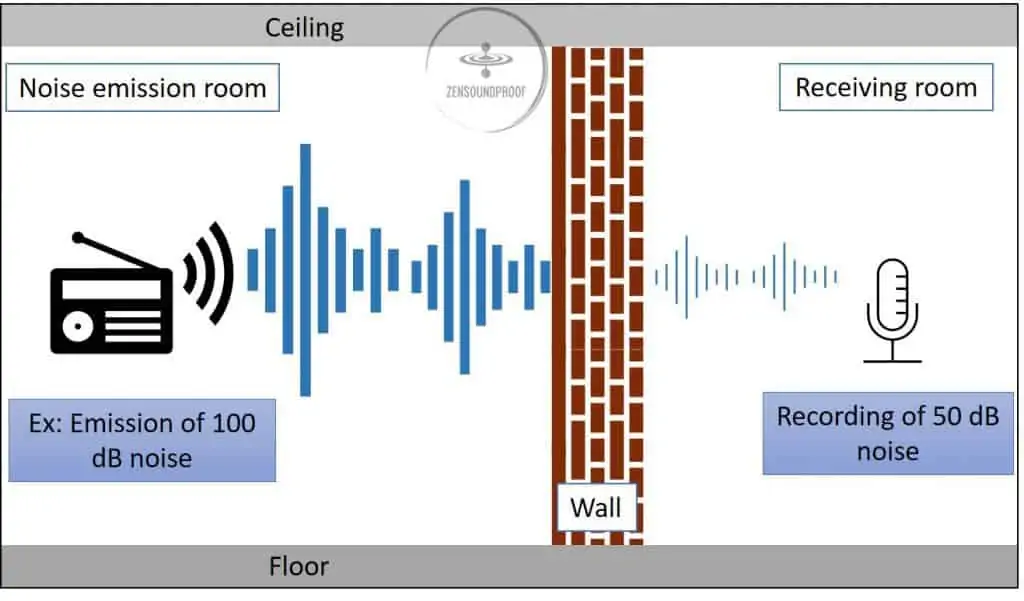
STC is not a perfect metric as it measures the noise transmission of the whole floor (or wall) assembly. Manufacturers test the STC for specific floor construction. If your floor construction differs, you won’t get the same STC rating when installing the material.
IIC
Impact Insulation Class is essentially the same measurement, but for impact sounds. The test involves setting up a tapping machine in a room and measuring the sound in the receiving room. The testing material is applied to the floor of the upper room, and a. measurement is taken.
As with STC, a higher value means better insulation. An IIC value of 50 is generally acceptable.
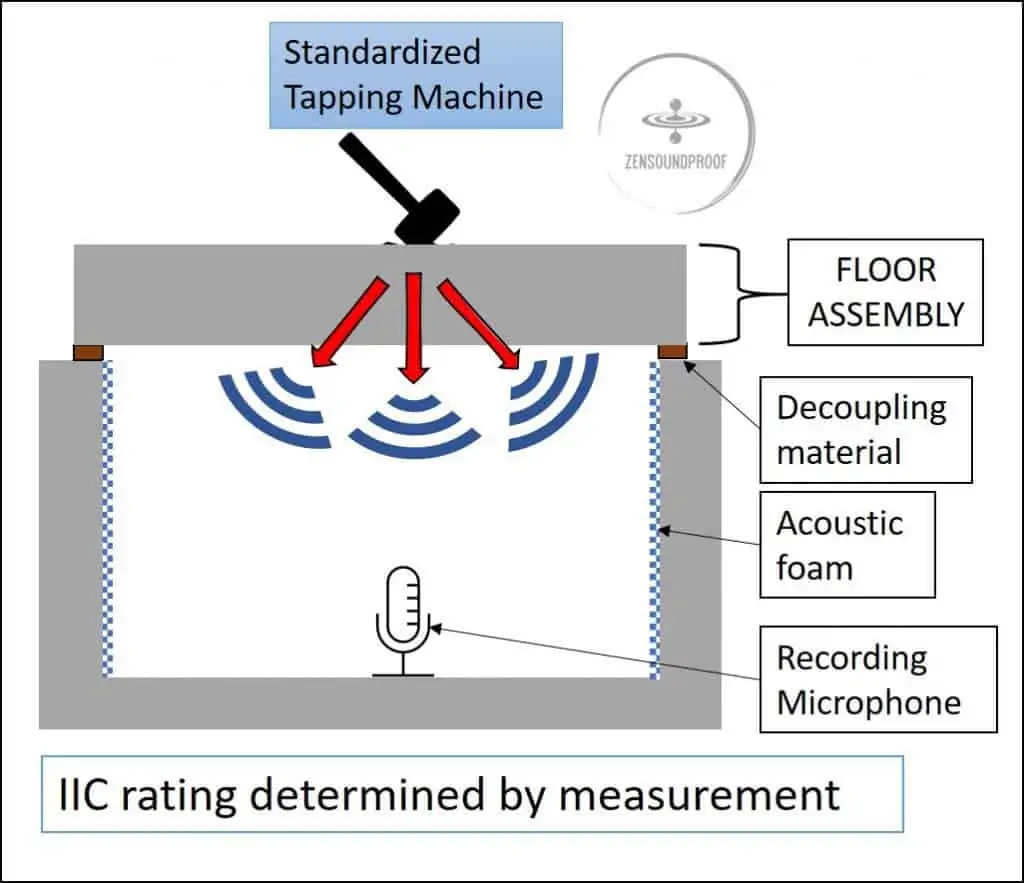
Just like STC, IIC is not a perfect metric as it measures the performance of the whole floor assembly. The solution to that is the Delta IIC rating.
Delta IIC
IIC is highly correlated to a floor’s construction (dropped ceiling, concrete slab, wood subfloor, etc.) meaning the same underlay can have different IIC values depending on what’s sitting underneath it. As such, a metric called Delta IIC is more accurate because removes extra variables to provide the underlay’s value alone. It works as follows:
1. Test a bare floor with no underlay, measuring the IIC.
2. Testing the same floor but with an underlay, measuring the IIC.
3. Deducting value 1 from value 2 to give the underlay’s specific IIC.
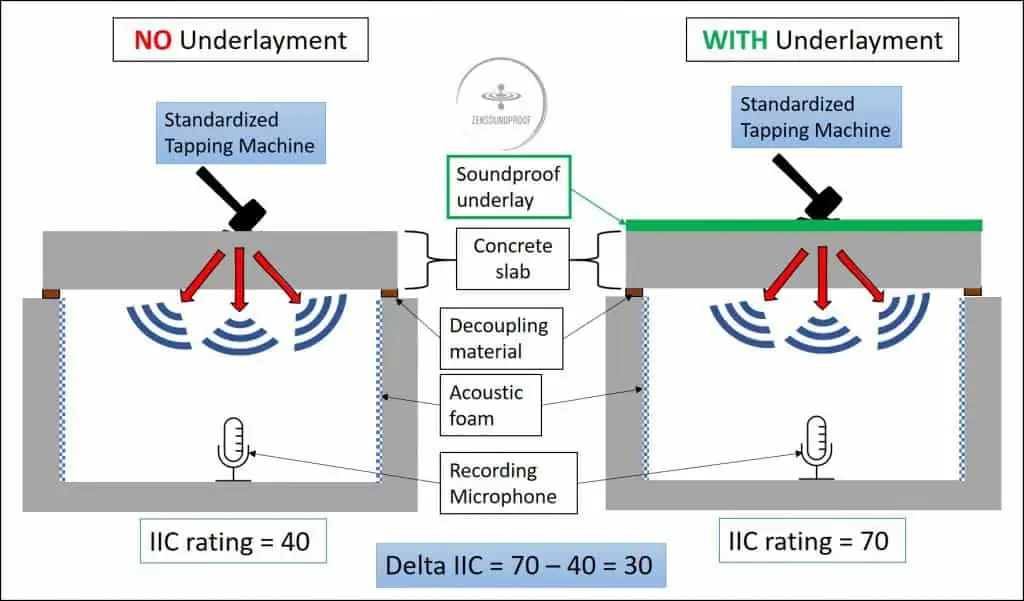
Unsurprisingly, Delta IIC values are lower than normal IIC. A value of 21 for a resilient material, such as foam or rubber, is perfectly acceptable.
NRC
NRC stands for Noise Reduction Coefficient. Whereas STC and IIC test sound transmission, NRC measures sound absorption.
Sound absorption is the process of a material absorbing sound energy. Sound waves are vibrations, and when they hit an absorptive material, they expend their energy making it vibrate. However, unlike brick, wood, glass, etc., absorptive materials essentially trap the sound waves rather than reflect them back into the room.
We can measure the NRC of a material by using the reverberation room method, which is where a sample of the material is placed at the center of the room, a sound source emits sounds, and microphones record the residual sound waves at different frequencies.
Some examples of sound absorbing materials are fiberglass insulation, rock or mineral wool, and acoustic foam. Rather than reducing sound transmission, absorption helps to control reverberation. While this is important in spaces such as recording studios (where we need clean sound), it’s helpful in the home too. Too much reverb makes a room sound echoey, which can impact things like watching TV or listening to music.
NRC is one of the easiest scales to understand because it’s given as a decimal:
- 1 means 100% absorption.
- 0 means no absorption.
However, the logic of a higher figure being better still stands.
What Matters in a Soundproof Carpet Underlay?
While the right carpet underlay depends on your flooring, space, and needs, there are some fairly standard factors to consider. To choose the best soundproof carpet underlay, you must think about the following:
Type of Material
Using the correct material is vital for soundproof underlay. It’s worth noting that there are plenty of carpet underlay materials, but not all of them are suitable as soundproof products. For it to reduce sound transmission effectively, you need something resilient and (ideally) dense.
Some examples include:
Urethane Foam
Urethane foam is dense and relatively thin. It’s also a fairly inexpensive option, although dedicated soundproofing products will cost more than standard foam carpet underlays.
Rubber
Rubber is a good soundproofing material because it can be dense and flexible while also providing a decent level of mass. You’ll often find the products with the highest STC and IIC ratings are rubber.
Felted Fibers
Felted fibers are often made from recycled fabrics that are felted together into a roll. It can provide an acceptable increase to STC and IIC values, but it won’t be as effective as the other materials above. This is because felted fibers are usually thinner and have less “bounce” than rubber or foam.
Useful Metrics for Choosing Materials
Along with picking a material, you must also consider some specific factors. I’ve listed these below based on recommendations from the Department of Housing and Urban Development (HUD). You can check out this table for its measurements.
Class
HUD defines 2 classes of carpet padding. Class 1 is for light and moderate traffic areas, such as domestic spaces. While you might think your living room or hallway is a heavy-traffic area, it’s not when compared to public spaces.
Class 2 is for heavy traffic public spaces, such as lobbies, receptions, hallways, stairs, etc. However, if you think a space in your home would benefit from a higher-class material, nothing is stopping you from using Class 2 materials.
Thickness
Thickness is pretty self-explanatory: it refers to how much height the underlay will add to your floor assembly. Of course, this could be limited because you might not be able to add a really thick underlay to an existing space.
Soundproof underlays can range from 1.6mm (1/16”) to 10mm (3/8”) or more.
Density
Arguably, density is a more important metric than thickness. For example, if a material is denser, it doesn’t need to be as thick, meaning you can save space in your room. You should ideally use both metrics, though, as a thicker and denser material will offer more noise reduction.
Density metrics can vary depending on where you’re buying from, but typically, we use lbs./cu. ft. (pounds per cubic foot).
I wouldn’t recommend going below 2 lbs./cu. ft. because that’s the minimum recommended density for urethane foam. For better soundproofing results, aim above the HUD recommendations of density depending on the material.
How to Improve NRC, IIC and STC
The Carpet and Rug Institute (CRI) conducted some comparative tests (Acoustical Characteristics of Carpet) to quantify the acoustical properties (NRC, IIC, and STC) of different types of carpet padding (also referred to as cushion material).
The conclusions of the testing are as follows. They’re worth keeping in mind when shopping for padding.
NRC
- Adding carpet padding to a carpeted floor increases the NRC by 0.1 to 0.2.
- Padding with higher weight, permeability, and thickness will increase NRC.
IIC
- Rubber performs better than polyurethane foam, which performs better than felted fibers.
- Weight for weight, foam rubber (i.e. slab rubber) is the material that delivers the best IIC rating.
- The heavier the padding, the better the IIC.
STC
- The heavier the padding, the better the STC rating improvement.
3 Best Carpet Padding for Soundproofing
Rather than doing a roundup of the best products on the market, below are some examples of things you could try. I have included specific products as examples, as some of them are pretty much the best types of carpet underlay. They should therefore give you an idea of the kinds of values and price you can expect from soundproof carpet underlay.
1. The Soundproof Carpet Pad Option
- Material: Rubber
- Thickness: 2 up to 12mm
- Area Density:
- 2mm thick: 54 oz/sq. yd
- 12mm thick: 288 oz/sq. yd
- Volume Density: ~51 lbs/cu.ft
- Delta IIC: 22 up to 26

For best results, something like Second Skin Audio’s UnderBlock will do the job. It’s rubber, meaning it’s heavy and dense. It comes in thicknesses ranging from 2mm to 12mm. As an example of its density, the 12mm roll is 51 lbs./cu. ft., which is way above the HUD recommendations.
Importantly, it has some decent metrics, arguably some of the highest numbers you’ll find for soundproof underlay. Second Skin has examples on its page – the Delta IIC ranges from 22 to 26. As for STC, you could achieve a rating of more than 70 depending on the rest of your floor’s construction.
Its weight means it’s relatively easy to install (other than carrying it!). You generally won’t need adhesive, as it’s heavy enough to not move around. You can cut it with a utility knife and then simply fit the carpet on top.
- Excellent Delta IIC rating.
- Easy to install.
- Ideal for domestic and commercial soundproofing projects.
- Could get pricey for larger rooms (but this is standard with these materials).
2. Normal Carpet Underlays
- Material: Felt + Rubber
- Thickness:
- 1/4″ (6.35mm)
- 7/16″ (11mm)
- Area Density:
- 1/4″ thick: 22 oz/sq. yd
- 7/16″ thick: 32 oz/sq. yd
- Volume Density: NC
- Delta IIC: NC
Provided you shop around for the best products, a normal carpet or rug underlay will definitely help. Rug Pad USA has some products in its lineup that can fit both functions of carpet rug and carpet padding.
For example, this 7/16” rug pad is recycled felted fiber. As discussed, this is the worst-performing material for a soundproof carpet padding, but it’s thick enough that it’ll definitely muffle impact sounds. It also has the benefit of a rubber back, which will stop the rug from slipping around.
Its density is 32 oz/sq. yd., which is above the 30 oz./sq. yd. recommended by the HUD. It means it’s a class 2 underlay for heavy traffic areas.
As far as IIC goes, it’s reasonable to assume a delta IIC of 20 based on the testing conducted by the CRI. As expected, it’s not the best but it’s definitely a decent rating for an underlay.
Unfortunately, it’s not always the best deal to go for a normal carpet underlay. In this case, the 7/16” thick Superior Lock is around $180 per 60 sq.ft while the Second Skin (½” thick) model is around $140 per 60 sq.ft.
However, there are other factors to consider such as comfort, as rubber might not offer the same level of feel underfoot. Of course, this is when you need to start balancing the benefits of a soundproof carpet pad against the other benefits of carpet padding (discussed below).
- Suitable for use as a carpet rug or as carpet padding.
- Helps with impact noise while also providing some sound absorption.
- Not the best deal.
- No clear delta IIC or IIC rating in the spec sheet.
3. The DIY Carpet Pad Option
Mass Loaded Vinyl
- Material: Vinyl
- Thickness: 1/4″ (6.35mm)
- Area Density: 288 oz/sq. yd (2 lbs/sq.ft)
- Volume Density: 96 lbs/cu.ft
- Delta IIC: NC
Polyurethane foam
- Material: Polyurethane foam
- Thickness: 7/16″ (11mm)
- Area Density: N/A
- Volume Density: 10 lbs/cu.ft
- Delta IIC: NC
Another option is to DIY your own carpet underlay. For this, I’d recommend using mass loaded vinyl and a roll of urethane foam.
- Mass loaded vinyl. I’d recommend using mass loaded vinyl with a density of 2 lbs./sq. ft., which has an STC rating of 32.
- Finding decent foam might be a bit harder, but something like this polyurethane carpet pad is a good example. Whatever product you choose, make sure you compare it to the HUD guidelines above for weight and density.
Essentially, it would work like this product from Trademark Soundproofing. It has an STC of either 26 or 33 depending on the thickness, so you can see how it achieves comparable results.
In terms of cost, you might end up paying more for this option. The Second Skin product is around $140 for 60 sq. ft., whereas the MLV alone is around $250 for 60 sq. ft. However, the benefit of a DIY option is that you can vary the materials you use.
The weight and density come from the MLV, which is a limp mass product. In short, this means sound waves hit the surface and dissipate, making it effective against airborne noise. In turn, it will increase STC. Sticking foam, on the other hand, provides decoupling by adding an extra layer of resilient material between the carpet and structure.
- More flexibility in terms of materials, sizes, etc.
- MLV has pretty good STC values.
- Ideal for impact and airborne sounds.
- Can get expensive for larger rooms.
Other Benefits of Carpet Padding
Although we’re discussing the soundproofing benefits of carpet padding, there are other advantages. These don’t necessarily relate to performance, but rather help with comfort and the carpet’s lifespan. Carpet padding can help with:
Insulation
As mentioned, sound and heat energy work in similar ways. As such, a product that insulates against sounds will often also insulate against heat. The metric we use for heat insulation is the R-value.
It measures a material’s ability to resist heat flow. R-values are based on a material’s thickness and thermal conductivity. The higher the R-value, the better a product can insulate.
Why is this important? Simply put, you don’t want heat to escape from your room. It works the other way around, too, in that high R-values stop heat from coming in (keeping your room cool). If you use heat and AC systems, you’ll want the best insulation possible.
Protection from Wear
Carpet padding reduces stress from wear caused by traffic. It stops the carpet’s underside (which holds the fibers in place) from rubbing against the bare floor. If this happens, fibers can come loose, causing the carpet to go bald. Also, it reduces impact on the fibers, meaning less matting and crushing.
Vacuuming is Easier
Everyone knows carpets need cleaning. But did you know carpet padding makes this easier? This is because decent carpet underlay will allow for airflow under the carpet, so the vacuum cleaner can more effectively suck up dirt and debris.
It similarly helps when you decide to shampoo your carpet. Extra airflow will help the carpet dry faster than if it were sitting on bare floorboards.
Makes the Carpet More Comfy
Carpet padding absorbs the shock of your walking on the floor, making it more comfortable. If you’ve got a particularly thick carpet pad, the floor will feel lovely and squishy when you walk on it.
Final Thoughts
Carpet padding is a necessary addition for insulation, noise reduction, and carpet longevity. If you plan to soundproof a space, I recommend using a dedicated soundproof carpet underlay for added noise reduction. Floors are easy to overlook, but sound treatment is vital if there’s a room underneath.
Hopefully, this article has given you some inspiration on what to look for and how to choose a suitable product. The exact materials and density will depend on your needs and the kinds of sounds you’re trying to reduce.
Do you have any other tips for choosing carpet underlay, or any products you’d recommend? Let me know in the comments, as I’m always happy to expand my list!



